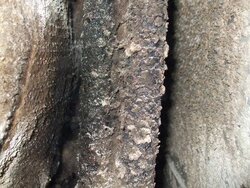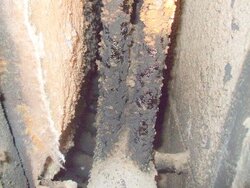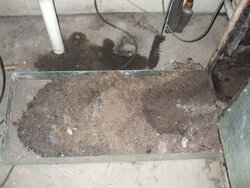Hi Mole, I just got done cleaning the ash out about an hour ago. While I was in there I thought I might as well check the tubes, chimney etc. The tubes had some soot build-up, altho not very bad. I took a 1/4" piece of aluminum angle I had laying around and was easily able to just run it up and down the tubes and all the junk just fell right off. I'm not seeing really any creosote build-up anywhere. the chimney just had a thin soot coating that came right off when I wiped my glove over it.
However, I can see that the vertical part of the tubes in the back look a little shiny, so maybe a little creosote there, and have more build-up on them, but not bad. I am going to try to design a device that I can slide up and down the tubes ocassionally, even down the vertical sections, that would keep the tubes relatively clean.
My Seton is definitely oversized as well, but so far I'm pleased with the way it performs. My wood consumption is going to be WAY down from years past with my Aquatherm. I still think I want to go with storage next year, I think it will help keep the unit operating even more efficiently and most importantly, cleaner.
I'm burning red oak that was cut almost 2 years ago and was cut up, split and stacked last May, so I think its fairly dry. Haven't checked the MC, but its a hell of a lot lighter then when I stacked it I can tell you that ! I have a lot of dying white birch around here I'm going to cut, split and stack in early spring to use during the day so I can save more of the oak for when I need it most. I probably have enough oak for at least 2 seasons now, and I could probably extend that to 3 seasons by mixing in some birch/soft maple. Then I only have to cut up about 2-3 cords of oak every year to replenish what I use.
I'm not sure what kind of wood you're burning, but I have to think that dryer wood will help keep the creosote build-up to a minimum, altho Fred seems to think it doesn't matter. He reiterated that large rounds, pretty much regardless of MC, were the best for burning in the Seton. I don't really agree with that, but haven't tried it yet either?
Totally agree about the efficiency issue. I was burning 10-12 cords every year in my Aquatherm, so anything under 7-8 cords for me will be a HUGE improvement. But I also want a stove that I don't have to worry about. With OWB's you really don't have to worry about creosote, but they are grossly inefficient. With these things you need to keep an eye on it, and if they are building up creosote then something isn't right, obviously. The last thing I want is to lay awake at night wondering when I'm going to have a roaring creosote fire erupt. So far it looks good, so I'm sleeping pretty well! LOL
take care, Pat





